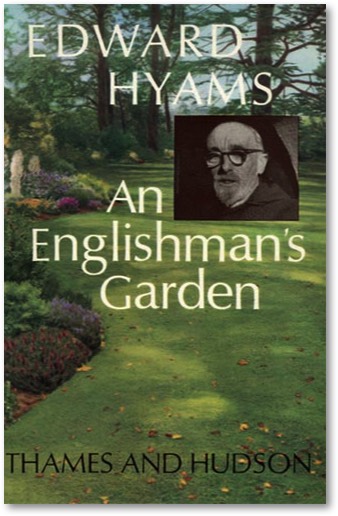
Musings » An Englishman's Garden


London
Thames and Hudson 1967
An Englishman’s Garden is but one of the 100 books Edward Hyams wrote. Hyams, 1910 – 1975, was a rather extraordinary man. He was born into a comfortably middle class family, well educated at excellent schools and when his father’s work took them to France attended a lycée in Paris and university in Lausanne. Hyams became completely bilingual and frequently translated significant books for the English market. Those of us old enough to have read Zoe Oldenbourg’s The Cornerstone will have read it in Hyams’ translation.
After serving in the Royal Navy in WWII he threw up his urban existence and moved permanently to a small property in Kent. The war had shown him the futility of his previous life and he wanted to get back to basics. Fortunately his wife agreed. In1961 they moved to a rather dilapidated vicarage in Devonshire and spent the next few years building a garden.
In the mornings Hyams wrote articles and books to earn enough money to keep them going. He spent the rest of the time doing very heavy manual labor in the garden. An Englishman’s Garden is the account of that experience. Country parsons received vast drafty houses with their livings because of their large families. That was fine as long as they came from the wealthy classes and used their own (or their wives’, see Barchester Towers) money to keep everything up. With the decline of the established English church all this changed and the vicarages were too expensive to maintain.
Landscove in Devonshire was a supreme example of this trend. It had 3 acres of land which once were a large garden. By the early 1960s the only vestiges of cultivation were several handsome cedar trees, some overgrown shrubs and mountains but mountains of rubbish. In each chapter of his book Hyams describes how he cleared different sections of the land, mainly by hand, graded it and then planted it. He chose his plants with extreme care.
Somewhere along the way Hyams had learned an enormous amount about horticulture, so much so he was the garden correspondent of a leading weekly magazine, The Illustrated London News. This was one of his sources of income. One of the useful by-products of his horticultural journalism was becoming friendly with the major figures in British gardening at the time. On every other page of his book he notes that he received cuttings of a rare species from one or another noted garden person.
Dartington Hall was not too far away in Devonshire. The garden had been designed by Beatrix Farrand and continued to be faithfully maintained by Jonathan Johnson, the gardener. While Hyams extolled the virtues of the garden and the gardener he did not mention Beatrix Farrand in his book. It may be he had not heard of her. He enjoyed Dartington Hall’s resources in the early 1960s and her reputation had not yet been restored to its former glory.
Hyams also visited amazing gardens in other part of the British Isles and experimented with plants which had flourished on the West coast of Ireland or high up in Scotland. The book offers penetrating commentary on their success or failure.
True to the rarified company he was keeping Hyams tended only to grow species plants. In the case of rhododendrons this was a profound contribution to gardening knowledge. He grew more than 40 species of this genus. I know because I have made a list of the 256 plants mentioned in the book. Occasionally he became a bit bombastic and pompous about the iniquities of hybrids, wholly undeserved in my opinion.
The strengths and weaknesses of the soil and climate in that part of Devonshire were key to the results he reported. Standard lilies grew magnificently as did many tender shrubs when carefully placed for protection from cold winds. A number of rhododendrons flourished in spite of soil which was not particularly acid. Native violets and primroses prospered under his trees and shrubs and he planted a number of very productive fruit trees. He was most impressed by a fecund lemon tree in his greenhouse, rare for him but not strange to us. It was a Meyer lemon…
After almost a decade of hard slogging the garden was “finished”. He sold up and moved away. Everyone knows that a garden is never finished but in his epilogue he commented that he had no wish to do the heavy work of maintenance. Under this insouciant attitude we now know the sale was probably due to the breakup of his marriage. Hyams met someone else and married her a year or two later. He was by then well into his 60s. They bought another “fixer upper” in Suffolk and proceeded to go through the whole cycle yet again.
In addition to horticulture Hyams had a profound interest in the history of anarchism. He died suddenly in France while doing research on the famous anarchist Pierre Proudhon and is buried in Besançon. Several of his books are minor classics and his contributions deserve more recognition. There has not been space in this review to do justice to his advanced views on soil maintenance and its importance for successful crops. For this alone we should remember his name.

